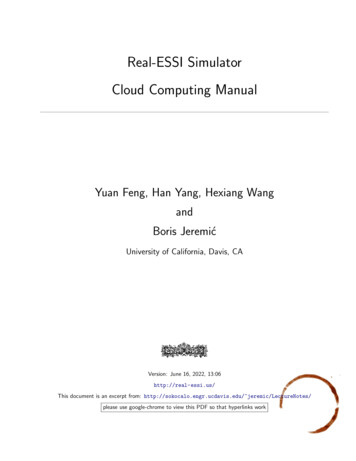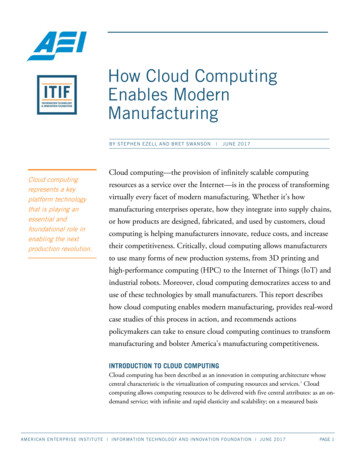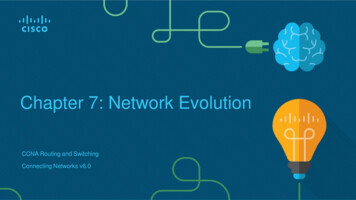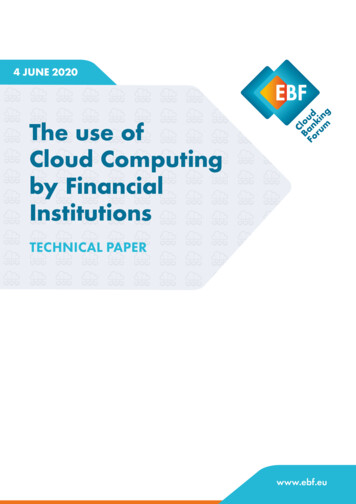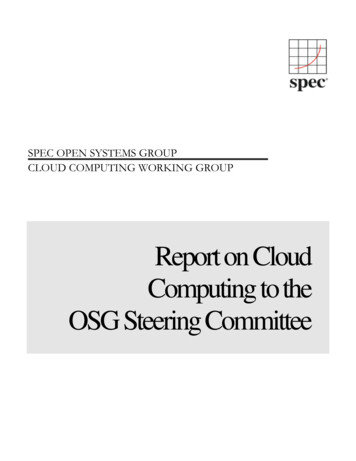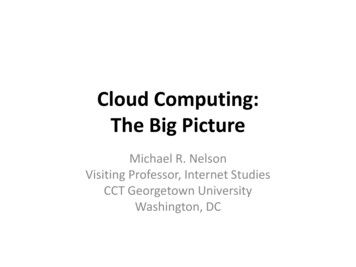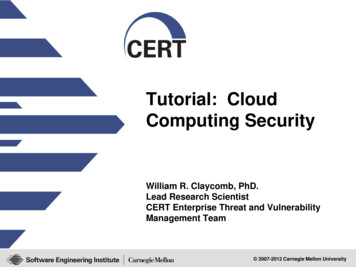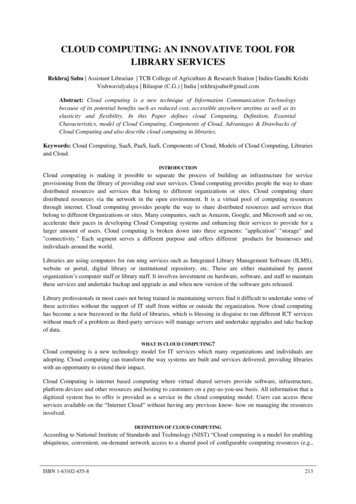
Transcription
CLOUD COMPUTING: AN INNOVATIVE TOOL FORLIBRARY SERVICESRekhraj Sahu Assistant Librarian TCB College of Agriculture & Research Station Indira Gandhi KrishiVishwavidyalaya Bilaspur (C.G.) India rekhrajsahu@gmail.comAbstract: Cloud computing is a new technique of Information Communication Technologybecause of its potential benefits such as reduced cost, accessible anywhere anytime as well as itselasticity and flexibility. In this Paper defines cloud Computing, Definition, EssentialCharacteristics, model of Cloud Computing, Components of Cloud, Advantages & Drawbacks ofCloud Computing and also describe cloud computing in libraries.Keywords: Cloud Computing, SaaS, PaaS, IaaS, Components of Cloud, Models of Cloud Computing, Librariesand Cloud.INTRODUCTIONCloud computing is making it possible to separate the process of building an infrastructure for serviceprovisioning from the library of providing end user services. Cloud computing provides people the way to sharedistributed resources and services that belong to different organizations or sites. Cloud computing sharedistributed resources via the network in the open environment. It is a virtual pool of computing resourcesthrough internet. Cloud computing provides people the way to share distributed resources and services thatbelong to different Organizations or sites. Many companies, such as Amazon, Google, and Microsoft and so on,accelerate their paces in developing Cloud Computing systems and enhancing their services to provide for alarger amount of users. Cloud computing is broken down into three segments: "application" "storage" and"connectivity." Each segment serves a different purpose and offers different products for businesses andindividuals around the world.Libraries are using computers for run ning services such as Integrated Library Management Software (ILMS),website or portal, digital library or institutional repository, etc. These are either maintained by parentorganization’s computer staff or library staff. It involves investment on hardware, software, and staff to maintainthese services and undertake backup and upgrade as and when new version of the software gets released.Library professionals in most cases not being trained in maintaining servers find it difficult to undertake some ofthese activities without the support of IT staff from within or outside the organization. Now cloud computinghas become a new buzzword in the field of libraries, which is blessing in disguise to run different ICT serviceswithout much of a problem as third-party services will manage servers and undertake upgrades and take backupof data.WHAT IS CLOUD COMPUTING?Cloud computing is a new technology model for IT services which many organizations and individuals areadopting. Cloud computing can transform the way systems are built and services delivered, providing librarieswith an opportunity to extend their impact.Cloud Computing is internet based computing where virtual shared servers provide software, infrastructure,platform devices and other resources and hosting to customers on a pay-as-you-use basis. All information that adigitized system has to offer is provided as a service in the cloud computing model. Users can access theseservices available on the “Internet Cloud” without having any previous know- how on managing the resourcesinvolved.DEFINITION OF CLOUD COMPUTINGAccording to National Institute of Standards and Technology (NIST) “Cloud computing is a model for enablingubiquitous, convenient, on-demand network access to a shared pool of configurable computing resources (e.g.,ISBN 1-63102-455-8213
Cloud Computing: An Innovative Tool For Library Servicesnetworks, servers, storage, applications, and services) that can be rapidly provisioned and released with minimalmanagement effort or service provider interaction.”According to the Gartner Group cloud computing as “a style of computing in which massively scalable andelastic IT-enabled capabilities are delivered as a service to external customers using Internet technologies.”According to the Forrester defines cloud computing as “A pool of abstracted, highly scalable, and managedcompute infrastructure capable of hosting end-customer applications and billed by consumption.”Cloud computing is a type of computing that relies on sharing computing resources rather than having localservers or personal devices to handle applications.Essential Characteristics of Cloud ComputingNIST has identified five essential characteristics of cloud computing: on-demand service, broad network access,resource pooling, rapid elasticity, and measured service. Cloud services exhibit five essential characteristics thatdemonstrate their relation to, and differences from, traditional computing approaches:On-demand self-service: A consumer can unilaterally provision computing capabilities such as server time andnetwork storage as needed automatically, without requiring human interaction with a service provider.Broad network access: Capabilities are available over the network and accessed through standard mechanismsthat promote use by heterogeneous thin or thick client platforms (e.g., mobile phones, laptops, and PDAs) aswell as other traditional or cloud based software services.Resource pooling: The provider’s computing resources are pooled to serve multiple consumers using a multitenant model, with different physical and virtual resources dynamically assigned and reassigned according toconsumer demand. There is a degree of location independence in that the customer generally has no control orknowledge over the exact location of the provided resources, but may be able to specify location at a higherlevel of abstraction (e.g., country, state, or data center). Examples of resources include storage, processing,memory, network bandwidth, and virtual machines. Even private clouds tend to pool resources betweendifferent parts of the same organization.Rapid elasticity: Capabilities can be rapidly and elastically provisioned in some cases automatically to quicklyscale out; and rapidly released to quickly scale in. To the consumer, the capabilities available for provisioningoften appear to be unlimited and can be purchased in any quantity at any time.Measured service: Cloud systems automatically control and optimize resource usage by leveraging a meteringcapability at some level of abstraction appropriate to the type of service (e.g., storage, processing, bandwidth, oractive user accounts). Resource usage can be monitored, controlled, and reported providing transparency forboth the provider and consumer of the service.Multi Tenacity: It is the 6th characteristics of cloud computing advocated by the Cloud Security Alliance. Itrefers to the need for policy driven enforcement, segmentation, isolation, governance, service levels, andchargeback/ billing models for different consumer constituencies.It is important to recognize that cloud services are often but not always utilized in conjunction with, and enabledby, virtualization technologies. There is no requirement, however, that ties the abstraction of resources tovirtualization technologies and in many offerings virtualization by hypervisor or operating system container isnot utilized.CLOUD COMPUTING MODELSCloud Providers offer services that can be grouped into three categories.Software as a Service (SaaS): In this model, a complete application is offered to the customer, as a service ondemand. A single instance of the service runs on the cloud & multiple end users are serviced. On the customers‟214ISBN 1-63102-455-8
National Conference on Library Information Science and Information Technology for Educationside, there is no need for upfront investment in servers or software licenses, while for the provider, the costs arelowered, since only a single application needs to be hosted & maintained. Today SaaS is offered by companiessuch as Google, Salesforce, Microsoft, Zoho, etc.Platform as a Service (PaaS): Here, a layer of software, or development environment is encapsulated &offered as a service, upon which other higher levels of service can be built. The customer has the freedom tobuild his own applications, which run on the provider’s infrastructure. To meet manageability and scalabilityrequirements of the applications, PaaS providers offer a predefined combination of OS and application servers,such as LAMP platform (Linux, Apache, MySql and PHP), restricted J2EE, Ruby etc. Google’s App Engine,Force.com, etc are some of the popular PaaS examples.Infrastructure as a Service (IaaS): IaaS provides basic storage and computing capabilities as standardizedservices over the network. Servers, storage systems, networking equipment, data centre space etc. are pooledand made available to handle workloads. The customer would typically deploy his own software on theinfrastructure. Some common examples are Amazon, GoGrid, 3 Tera, etc.Cloud computing is defined to have several deployment models, each of which provides distinct trade-offs foragencies which are migrating applications to a cloud environment. NIST defines the cloud deployment modelsas follows:Private cloud: The cloud infrastructure is operated solely for an organization. It may be managed by theorganization or a third party and may exist on premise or off premise.Community cloud: The cloud infrastructure is shared by several organizations and supports a specificcommunity that has shared concerns (e.g., mission, security requirements, policy, and complianceconsiderations).It may be managed by the organizations or a third party and may exist on premise or offpremise.Public cloud: The cloud infrastructure is made available to the general public or a large industry group and isowned by an organization selling cloud services.,bascvffr4u7 Hybrid cloud: The cloud infrastructure is a composition of two or more clouds (private, com munity, orpublic) that remain unique entities but are bound together by standardized or proprietary technology that enablesdata and application portability (e.g., cloud bursting for load-balancing between clouds).COMPONENTS OF CLOUDA Cloud system consists of three major components such as clients, data centre and distributed servers. Eachelement has a definite purpose and plays a specific role.Clients: Clients are in a cloud computing architecture are similar to the clients of everyday local area network(LAN). These are the computers which are residing on the desk of the end users. This is where the front-endapplications are installed. They can be laptops, tablet computers, mobile phones or PDAs. In short clients are thedevices at the user side and used to manage client information. The physical specification brings the client intothe following three categories. Mobile- Mobile devices include smart phones, Tablets or PDAs.Thin-These are the dump terminals having no hard disk space rather it let the servers do all processingactivities. It simply displays the information.Thick- This type of client is a regular computer, using a web browser like Firefox or Internet Explorerto connect to the cloud.Data Centre: The data centre is the collection of servers where the applications to which the user subscribes arehosted. A data centre server can be virtualized in nature where the software can be installed in the main physicalserver but appeared as separate server identity to the user. In this way, one can have half a dozen virtual serversrunning on one physical server.ISBN 1-63102-455-8215
Cloud Computing: An Innovative Tool For Library ServicesDistributed Servers: It is not necessary that the data centre always contains only one server in our place.Sometimes servers are placed in geographically disparate locations in the globe. But from the end userperspective it seems that data is coming from a central server. In this approach if one server is down or instantlynot available to a client request, may be due to congestions etc., the other services activate to cater the clients. Inorder to provide seamless service to the client, the data in these servers are synchronized frequently.ADVANTAGES OF CLOUD COMPUTING IN LIBRARY SERVICE Cost reduction- Ability to increase or decrease the consumption of hardware or software resourcesimmediately and in some cases automatically.Scalability- “Pay as you go” allowing a more efficient control of expenditures.Lower investment, reduced risk- Immediate access to the improvements in the resource proposed(hardware and software) and debugging.Support included- Enjoyment of the most advanced security procedures, availability and performanceof providers with experience and knowledge in this type of service.Greater security and accessibility- Access to resources from any geographical point and the ability totest and evaluate resources at no cost.Portability- since the service is available over the web, the service can be availed through browser fromany part of the world.Adjustable storage- In the traditional system, if the server is less than what we have. The server shouldbe replaced with the new one. In this computing, the storage capacity can be adjusted according to theneeds of the library, since the storage is controlled by the service provider.Cloud OPAC- Most of the libraries in the world are having the catalogue over the web. Thesecatalogues are available with their libraries local server made it available over the web. If the catalogueof the libraries made it available through cloud, it will be more benefit to the users to find out theavailability of materials.DRAWBACKS OF CLOUD COMPUTINGThe drawbacks are actually the same as those encountered by institutions that have information hosted outsideof the entity. Whereas, in the case of hard-copy document files and at the enterprise level, this fear disappearedyears ago, given the benefits of cost reduction in infrastructure management and security, in the case of digitaldata there is still a huge fear of putting our information in the hands of third parties. This fear arises due toissues such as confidentiality, theft, loss etc. Yet people are increasingly more likely to do so now that the use ofWeb 2.0 and social networks has become so widespread. There is nothing more sensitive than banking orpersonal data, yet this data is stored in servers over which we have no domain or ownership.An institution might take the decision to progressively move towards Cloud Computing by uploadingapplications which are not very sensitive such as: messaging, the booking of rooms, meeting management, theliquidation of costs, and holiday management. Following this learning process, more valuable informationinvolving the corpus of the institution, i.e. “Business intelligence” might be uploaded to the cloud. In the case oflibraries and information centers, this information would include management funds and network transactions.LIBRARIES AND CLOUDSToday we are living in the age of information. Information technology plays a very vital role in handing libraryresources ranges from collection, storage, organization, processing, and analysis of information dissemination.Library field facing many challenges in the profession due to applications of information technology. Newconcepts and technologies are being added to ease the practices in the libraries and satisfy the needs of theknowledge society. With the advent of information technology, libraries have become automated which is thebasic need towards advancement followed by networks and more effort are towards virtual libraries.The emergence of digital library, internet usage, web tools application for libraries, consortium practices leadsto the advancement in library profession. Cloud computing is a completely new IT technology and it is knownas the third revolution after PC and internet in IT. The later technology trend in library science is use of cloudcomputing for various purposes and for achieving economy in library functions. Since cloud computing is a new216ISBN 1-63102-455-8
National Conference on Library Information Science and Information Technology for Educationand core area the professionals should be aware of it and also the application of cloud computing in libraryscience.CONCLUSIONLibraries are moving towards cloud computing technology in present time and taking advantages of cloud basedservices especially in digital libraries, social networking and information communication. Therefore it is timefor libraries think seriously for libraries services with cloud based technologies and provide reliable and rapidservices to their users. Another role of LIS professionals in this virtual era is to make cloud based services as areliable medium to disseminate library services to their users with ease of use and save the time of users.REFERENCES[1] view.pdf[2] https://www.priv.gc.ca/resource/fs-fi/02 05 d 51 cc e.pdf[3] https://www.nsa.gov/research/ files/publications/cloud computing overview.pdf[4] http://www.tutorialspoint.com/cloud computing/cloud computing tutorial.pdf[5] http://broadcast.rackspace.com/hosting uting-Stack.pdf[6] /s13677-014-0021-5.pdf[7] iles/IFLA-winds-of-change-paper.pdf[8] ile/3.4.9/pdf[9] http://www.kiit.ac.in/centrallibrary/pdf/pdf presentation/Impact of Cloud Computing on Library Services.pdf[10] http://www.ijodls.in/uploads/3/6/0/3/3603729/vol. 2 july - sept. 2012 part-2.pdf[11] http://www.emeraldinsight.com/journals.htm?issn 0888045X&volume 25&issue 3&articleid 17062886&show html&PHPSESSID ufq4bgqsp3hpbd70rru9dfc8t4[12] http://www.webopedia.com/TERM/C/cloud computing.html[13] http://csrc.nist.gov/publications/nistpubs/800- 145/ SP800-145.pdf[14] Journal of Commerce & Management Thought IV – 2 ISSN 0975-623X(print)0976-478X(online) CloudComputing : An Innovative Tool for Business Progress Manju Mittal Prathiba L.[15] iles/IFLA-winds-of-change-paper.pdf[16] Bhattacharjee, N., & Das Purkayastha, S. (2013). Cloud computing and its applications in libraries. e-Library ScienceResearch Journal, 1(7).[17] Kumar, D. A., & Mandal, S. (2013). Development of cloud computing in integrated library management and retrievalsystem. International Journal of Library and Information Science, 5(10), 394-400.ISBN 1-63102-455-8217
Cloud computing is a type of computing that relies on sharing computing resources rather than having local servers or personal devices to handle applications. Essential Characteristics of Cloud Computing NIST has identified five essential characteristics of cloud computing: on -demand service, broad network access,




